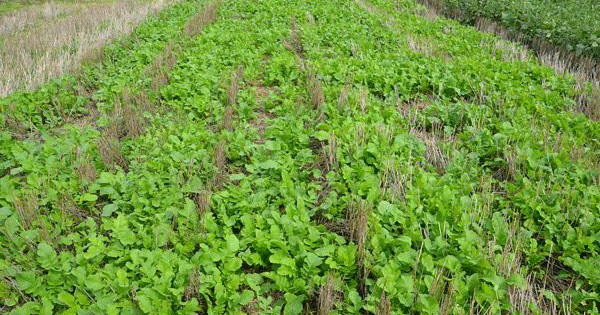 August 14, 2019 – Cover cropping is an important practice for building soil health, protecting the soil surface from erosion and compaction, and suppressing weeds and pests. Truly sustainable agriculture relies on maintaining effective vegetative cover of the soil, and the National Organic Standards require certified organic producers to include cover crops in their crop rotations.
August 14, 2019 – Cover cropping is an important practice for building soil health, protecting the soil surface from erosion and compaction, and suppressing weeds and pests. Truly sustainable agriculture relies on maintaining effective vegetative cover of the soil, and the National Organic Standards require certified organic producers to include cover crops in their crop rotations.
The Natural Resources Conservation Service has developed four basic principles of soil health management in which cover crops play key roles.
Keep the soil covered as much as possible.
– Year-round living vegetation or residue cover protects the soil from rain, wind, and sun, prevents erosion and crusting, adds organic matter, and feeds soil life.
– Timely cover crop planting after harvest can largely eliminate bare fallow, which might otherwise exceed six months per year in a corn-soybean rotation.
Keep living roots growing throughout the year.
– Rhizodeposition (root exudates and fine root sloughing) provides a continuous supply of food for beneficial soil microbes—the more living roots, the better.
– The deep, extensive root systems of mature cover crops enhance drainage and aeration, and bring organic matter and soil life deeper into the soil profile.
– Cover crop roots recover leached nutrients, thereby protecting water quality and enhancing fertility for the subsequent crop that is planted.
Manage more by disturbing soil less.
– Cover crops reduce chemical soil disturbances by lessening the need for soluble fertilizers, pesticides, and herbicides.
– Cover crops reduce biological disturbance by supporting soil life year round.
– Cover crops can reduce physical soil disturbances by suppressing weeds and lessening the need for tillage and cultivation.
Diversify soil biota with plant diversity.
– Adding cover crops to an existing rotation enhances diversity of plant species, and thereby the community of root-associated soil organisms.
– Cover crop mixes further improve diversity.
However, it can be difficult to determine the best cover crop to plant, the optimum time to plant, when and how to terminate; and of course, how to calculate the all-important return on investment. The good news is that there are plenty of free resources available to help farmers make these critical decisions.
OFRF’s series on Soil Health and Organic Farming includes a guidebook and webinar on cover cropping. Cover Crops for Soil Health: Selection and Management provides an analysis of the most current research on cover cropping to guide growers through the process of selecting and managing cover crops. All of the guidebooks and webinars are available for free.
Sustainable Agriculture Research & Education (SARE) added to their many excellent resources in June of this year with a Technical Bulletin called “Cover Crop Economics: Opportunities to Improve Your Bottom Line in Row Crops”. The bulletin discusses both the immediate benefits of cover crops and their value as an investment in the long-term success of a farm.


